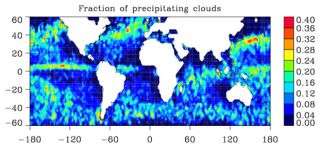NASA Satellites Help Lift Cloud of Uncertainty on Climate Change

New findings from NASA's CloudSat and other spacecraft in NASA's "A-Train" constellation of five Earth observing satellites offer important insights into this year's record reduction of Arctic sea ice, global rainfall patterns and the effects of pollution on clouds.
The investigations are giving scientists a greater understanding of factors influencing Earth's present climate and an important foundation for better understanding long-term climate change.
Speaking at the fall meeting of the American Geophysical Union in San Francisco, Graeme Stephens, CloudSat principal investigator and professor of atmospheric science at Colorado State University, Fort Collins, Colo., outlined results of several recent studies currently in peer review.
In one study, a team led by Jennifer Kay at the National Center for Atmospheric Research, Boulder, Colo., examined the influence of polar clouds on 2007's record low extent of Arctic sea ice. Using data from CloudSat and NASA's Cloud-Aerosol Lidar and Infrared Pathfinder Satellite Observation satellite, they found the total cloud cover over the western Arctic, where most of the ice loss occurred, was 16 percent less over the 2007 melt season than in 2006. The resulting clearer skies in 2007 heated the Arctic surface enough to warm ocean waters by 2.4 degrees Celsius (four degrees Fahrenheit) or enough to melt 0.3 meters (one foot) of sea ice. Anomalous clouds, in addition to other weather factors, helped melt ice that had already thinned due to sustained warming in recent years.
The results highlight the importance of weather pattern variability to a warming Arctic environment. "As Arctic sea ice thins, its extent is more sensitive to year-to-year variability in weather and cloud patterns," said Kay. "Our data show that clearer skies this summer allowed more of the sun's energy to melt the vulnerably thin sea ice and heat the ocean surface."
A separate CloudSat study led by John Haynes at Colorado State University found it rains more often and in greater amounts over Earth's oceans than previously estimated. The team found that, on average, 13 percent of clouds over Earth's oceans produce rain that reaches the surface. The difference in total rainfall amount estimates was greatest during winter, when large storms produced much more rainfall than previously estimated.
"These results suggest there is considerably more water falling from our skies, at least over Earth's oceans, than we previously thought," said Haynes. "The implications of these results are substantial and are still being examined, and suggest it may be necessary to reassess climate model estimates of Earth's water cycle intensity. By improving our understanding of present rainfall patterns, scientists can also improve climate model projections of how rainfall will increase or decrease in the future around the world."
CloudSat is providing some of the first, most direct observations of where rainfall occurs on a near-global basis, allowing scientists to see, for the first time, what fraction of Earth's clouds precipitate. It surveys ocean regions where measurements did not previously exist -- regions where the United Nations' Intergovernmental Panel on Climate Change suggests the greatest changes are occurring. It complements NASA's Tropical Rainfall Measuring Mission and offers a test bed for its planned Global Precipitation Measurement mission.
In another study, Colorado State University student Matt Lebsock and Stephens found the first global evidence that pollution of clouds by aerosols -- small particles suspended in the atmosphere -- is indeed making clouds brighter and more reflective, reducing the amount of sunlight available to warm the surface. These indirect aerosol effects are not well understood and create major uncertainties in climate models. The team combined data from CloudSat with the Advanced Microwave Scanning Radiometer-Earth Observing System and Moderate Resolution Imaging Spectroradiometer instruments on NASA's Aqua satellite.
Scientists had previously believed that aerosols indirectly altered sunlight reflected by clouds by altering the sizes of cloud particles. The new observations also show that aerosols might allow clouds to grow deeper, increasing the amount of sunlight reflected from them even more than previously thought.
The Afternoon, or "A-Train" satellite constellation presently consists of five satellites flying in formation around the globe. Each satellite within the A-Train has unique measurement capabilities that greatly complement each other. The combined set of measurements is providing new insights into the global distribution and evolution of clouds that will lead to improvements in weather forecasting and climate prediction.
Source: NASA/JPL




















